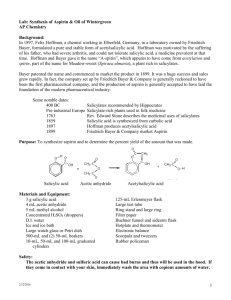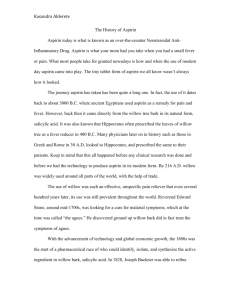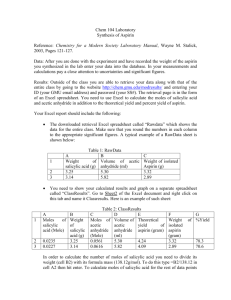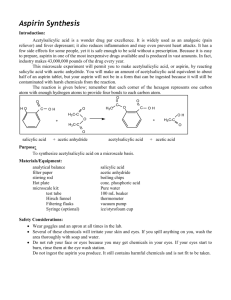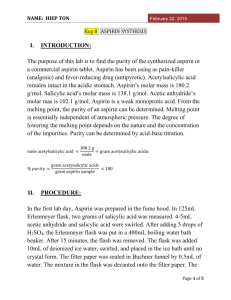handout aspirin synthesis
advertisement
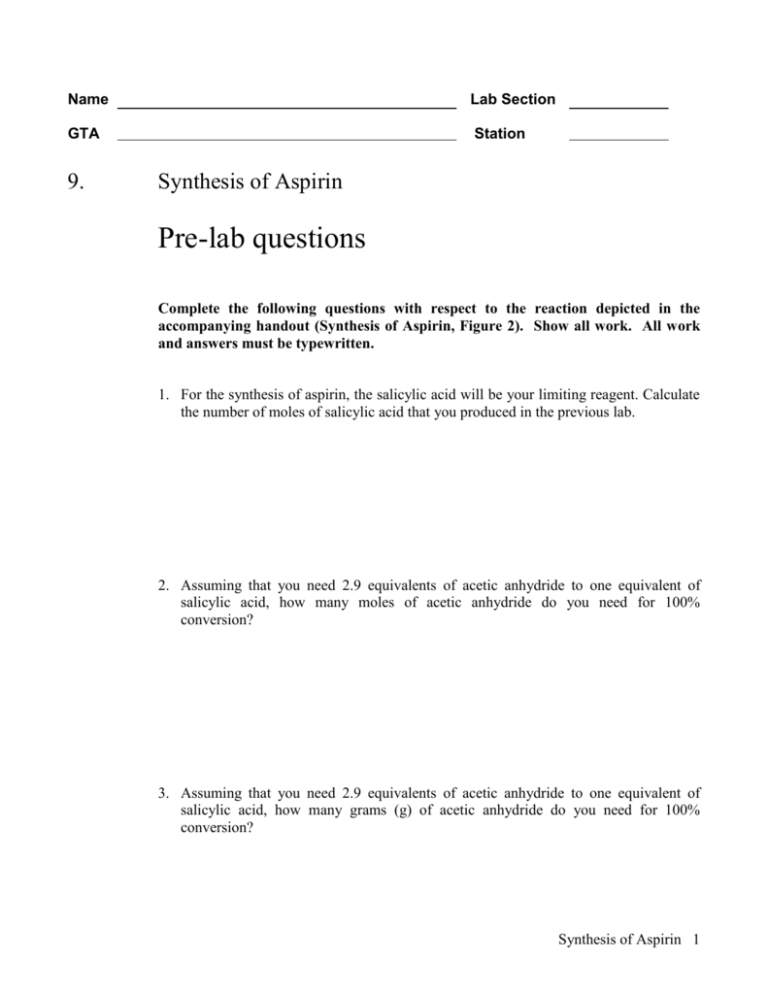
Name Lab Section GTA Station 9. Synthesis of Aspirin Pre-lab questions Complete the following questions with respect to the reaction depicted in the accompanying handout (Synthesis of Aspirin, Figure 2). Show all work. All work and answers must be typewritten. 1. For the synthesis of aspirin, the salicylic acid will be your limiting reagent. Calculate the number of moles of salicylic acid that you produced in the previous lab. 2. Assuming that you need 2.9 equivalents of acetic anhydride to one equivalent of salicylic acid, how many moles of acetic anhydride do you need for 100% conversion? 3. Assuming that you need 2.9 equivalents of acetic anhydride to one equivalent of salicylic acid, how many grams (g) of acetic anhydride do you need for 100% conversion? Synthesis of Aspirin 1 4. Assuming that you need 2.9 equivalents of acetic anhydride to one equivalent of salicylic acid, how many milliliters (mL) of acetic anhydride do you need for 100% conversion? 5. What is a catalyst? Pre-lab Notebook preparation Prepare the following in your lab notebook before beginning the experiment. 1. Start a new page by entering the title of this experiment. 2. Start a section with the subtitle “Reaction” and provide both the balanced equation and mechanism for the reaction you will be completing in lab. 3. Start a section with the subtitle “Procedure” and provide an outline of the experimental procedure to be carried out. Synthesis of Aspirin 2 9. Synthesis of Aspirin Jones: Esterification, pg 896-904, Figure 18.34 McMurry: Esterification, pg 317-318, 323 This procedure has been adapted from the microscale procedure described in Experimental Organic Chemistry A Balanced Approach: Macroscale and Microscale by Jerry R. Mohrig, Terrence C. Morrill, Christina Noring Hammond, and Douglas C. Neckers. Background Salicylic acid is the active ingredient in aspirin that causes pain relief. However this acid is too harsh on the mucous membranes in the mouth, esophagus, and stomach. An acetyl group is added to buffer the effects of the acid. In commercial aspirin there is 0.325 g of acetylsalicylic acid and a binder is used to hold it into tablet form. H O O H O H O O O CH3 O Salicylic acid Acetylsalicylic acid (aspirin) O O H 3C N H Acetaminophen H CH3 H 3C CH CH3 CH OH O C H2 Ibuprofen Figure 1. Typical analgesics. In this experiment you will continue your study of natural product synthesis by taking your previously synthesized salicylic acid and preparing aspirin. Transformation of the hydroxyl functional group will be achieved by utilizing an esterification reaction, which is the reaction of a carboxylic acid with an alcohol to form a carboxylate ester. You will be using acetic anhydride and salicylic acid as your carboxylic acid and alcohol. This reaction is acid catalyzed using phosphoric acid as the catalyst. Synthesis of Aspirin 3 H O O O H O O H O O + O O H2PO4 Acetic Anhydride bp 139 o C M.W. 102, d 1.08 HO + O CH3 CH3 Salicylic acid mp 160 oC M.W. 138 CH3 Acetylsalicylic acid (aspirin) mp 135-136 oC M.W. 180 O CH3 Acetic acid Figure 2. Balanced equation for the synthesis of aspirin. H O H O H OH2 O O H O O H O O O protonation acid/base rxn O O H 3C O O H OH2 deprotonation acid/base rxn O O H 3C CH3 O O CO2H H addition H CO2H H CH3 O CH3 CH3 O CH3 CH3 H O protonation acid/base rxn H OH2 CO2H O O H 3C CH3 O O H CO2H H 3C elimination O O CO2H + H O O CH3 Figure 3. Complete mechanism for synthesis of aspirin Synthesis of Aspirin 4 Experiment This is the second reaction of your two-step synthesis for the formation of aspirin. Your salicylic acid must be dry before you can proceed. 6. Place 300 mL of water into a 400 mL beaker. Add a paper clip to the beaker and place on a hotplate. Turn on the stirrer and heat the water on low (45-50 °C). 7. If you have not already, weigh your salicylic acid and transfer it to your reaction tube. 8. To the tube, add your calculated amount of acetic anhydride. 9. Add five (5) drops of phosphoric acid and mix the chemicals by swirling your reaction tube. 10. Loosely cap the tube, and allow the mixture to stand for ten minutes. The reaction mixture may become warm because the reaction is exothermic. 11. Heat the reaction for another five minutes using the water bath (45-50 °C). 12. Let the reaction cool to room temperature and then place the tube in an icewater bath. Scratch the side of the tube with your glass rod to initiate crystallization. 13. Add 10 mL of cold water and 6 g of ice to the reaction tube. 14. Break up the pasty solid with your glass rod. 15. After the ice has melted, collect the solid using vacuum filtration making sure to remove all of the water from the solid. 16. Recrystallize the solid from ethanol. ---For your lab report, report your crude and purified %yields. Also, take the melting point of your purified solid. Synthesis of Aspirin 5 Name Lab Section GTA Station 9. Synthesis of Aspirin Post-lab report 1. Draw (by hand) the complete reaction mechanism for your reaction. 2. Fill out the following table. Responses must be typewritten. Show all calculations. Initial Weight of salicylic acid (in g) Initial amount of salicylic acid (in moles) Theoretical yield of aspirin (in moles) Theoretical yield of aspirin (in g) Actual yield of aspirin ( in g) % yield melting point (°C) Synthesis of Aspirin 6


